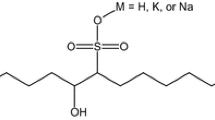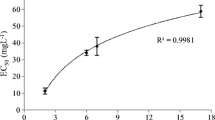Abstract
Synthetic surfactants in cleaners and detergents commonly contaminate freshwater systems, therefore use of low-toxicity alternatives is becoming increasingly important. Alkyl polyglucosides (APGs) derived from natural products are less toxic than synthetic surfactants, and degrade rapidly reducing chemical exposure time. However, single species toxicity tests showed APGs have toxic effects on aquatic primary producers and zooplankton, and that species demonstrate different sensitivities to APGs. Furthermore, species unaffected by APGs directly may be indirectly affected by removal of a food source or changes in predator densities, thereby changing plankton community structure. To determine the effects of APGs on plankton communities under environmental conditions, floating mesocosms were deployed in a shallow pond in southeast Georgia, USA and dosed with 0, 0.01, 2.5, 5, or 10 mg L−1 APG. Zooplankton community composition and abundance, phytoplankton abundance (as chlorophyll a), and water column dissolved oxygen concentration were determined weekly for 1 month. Zooplankton abundance decreased primarily due to loss of copepods, and community composition shifted toward small-bodied cladocerans (Bosmina sp.), and chlorophyll a concentrations declined by up to 81 % following exposure to APG concentrations of 2.5 mg L−1 or greater. Concentrations of dissolved oxygen never dropped below 5.70 mg L−1, but the observed declines of ~2 mg L−1 could become stressful during periods of high water temperatures. Nevertheless, the APG-induced shift from copepod to cladoceran dominated communities and decrease in autochthonous carbon availability has important implications for food availability and quality to higher trophic levels such as planktivorous fishes.





Similar content being viewed by others
References
Arar J, Collins G (1997) In vitro determination of Chl a and Pheo a in marine and freshwater algae by fluorescence. EPA Method, 445
Atkinson SF et al (2009) Use of watershed factors to predict consumer surfactant risk, water quality, and habitat quality in the upper Trinity River, Texas. Sci Total Environ 407:4028–4037
Ban S, Makino W, Sakano H, Haruna H, Ueda H (2013) Annual variation in biomass and the community structure of crustacean zooplankton over 5 years in Lake Toya, Japan. Limnology 14:59–70
Beisner BE, McCauley E, Wrona FJ (1997) The influence of temperature and food chain length on plankton predator-prey dynamics. Can J Fish Aquat Sci 54:586–595
Bikiaris D, Aburto J, Alric I, Borredon E, Botev M, Betchev C, Panayiotou C (1999) Mechanical properties and biodegradability of LDPE blends with fatty-acid esters of amylose and starch. J Appl Polym Sci 71:1089–1100
Brandl Z (2005) Freshwater copepods and rotifers: predators and their prey. Hydrobiologia 546:475–489
Brooks JL, Dodson SI (1965) Predation, body size, and composition of plankton. Science 150:28–35
Byron ER, Folt CL, Goldman CR (1984) Copepod and cladoceran success in an oligotrophic lake. J Plankton Res 6:45–65
Carpenter SR, Stanley EH, Vander Zanden MJ (2011) State of the world’s freshwater ecosystems: physical, chemical, and biological changes. Annu Rev Environ Resour 36:75–99
Clarke K, Gorley R (2006) User manual/tutorial. PRIMER-E Ltd, Plymouth
Clarke KR, Somerfield PJ, Chapman MG (2006) On resemblance measures for ecological studies, including taxonomic dissimilarities and a zero-adjusted Bray-Curtis coefficient for denuded assemblages. J Exp Mar Biol Ecol 330:55–80
DeMott WR (1982) Feeding selectivities and relative ingestion rates of Daphnia and Bosmina. Limnol Oceanogr 27:518–527
Eichhorn P, Knepper TP (1999) Investigations on the metabolism of alkyl polyglucosides and their determination in waste water by means of liquid chromatography–electrospray mass spectrometry. J Chromatogr A 854:221–232
Fleeger JW, Carman KR, Nisbet RM (2003) Indirect effects of contaminants in aquatic ecosystems. Sci Total Environ 317:207–233
Foekema EM, Kaag N, van Hussel DM, Jak RG, Scholten MCT, van der Guchte C (1998) Mesocosm observations on the ecological response of an aquatic community to sediment contamination. Water Sci Technol 37:249–256
GADNR (2012) 391-3-6-.03 Water use classifications and water quality standards
Garcia MT, Ribosa I, Campos E, Leal JS (1997) Ecological properties of alkylglucosides. Chemosphere 35:545–556
Gifford DJ, Caron DA (2000) Sampling, preservation, enumeration and biomass of marine protozooplankton. In: Huntley RHWLRS (ed) ICES zooplankton methodology manual. Academic Press, London, pp 193–221
Gillooly JF (2000) Effect of body size and temperature on generation time in zooplankton. J Plankton Res 22:241–251
Goswami S (2004) Zooplankton methodology, collection & identyification-A field manual. NOAA
Hanazato T, Yasuno M (1987) Experimental studies on competition between Bosmina longirostris and Bosmina fatalis. Hydrobiologia 154:189–199
Havens KE, Hanazato T (1993) Zooplankton community responses to chemical stressors: a comparison of results from acidification and pesticide contamination research. Environ Pollut 82:277–288
Homer DH, Waller WT (1983) Chronic effects of reduced dissolved-oxygen on Daphnia magna. Water Air Soil Pollut 20:23–28
Joyce K, Todd RL, Asmussen LE, Leonard RA (1985) Dissolved oxygen, total organic carbon and temperature relationships in southeastern U.S. coastal plain watersheds. Agric Water Manag 9:313–324
Jurado E, Fernandez-Serrano M, Nunez-Olea J, Luzon G, Lechuga M (2009) Acute toxicity and relationship between metabolites and ecotoxicity during the biodegradation process of non-ionic surfactants: fatty-alcohol ethoxylates, nonylphenol polyethoxylate and alkyl polyglucosides. Water Sci Technol 59:2351–2358
Juttner I, Peither A, Lay JP, Kettrup A, Ormerod SJ (1995) An outdoor mesocosm study to assess ecotoxicological effects of atazine on a natural plankton community. Arch Environ Contam Toxicol 29:435–441
Kerfoot WC (1977) Implications of copepod predation. Limnol Oceanogr 22:316–325
Kimmerer WJ, Ferm N, Nicolini MH, Peñalva C (2005) Chronic food limitation of egg production in populations of copepods of the genus Acartia in the San Francisco estuary. Estuaries 28:541–550
Klaffke H, Neubert T, Kroh L (1998) Analysis of alkyl polyglucosides using liquid chromatographic methods. Tenside Surfactants Deterg 35:108–111
Lewis MA (1991) Chronic and sublethal toxicities of surfactants to aquatic animals: a review and risk assessment. Water Res 25:101–113
Lewis WM, Saunders JF (1979) Two new integrating samplers for zooplankton, phytoplankton, and water chemistry. Arch Hydrobiol 85:244–249
Lopez-Mancisidor P, Carbonell G, Fernandez C, Tarazona JV (2008) Ecological impact of repeated applications of chlorpyrifos on zooplankton community in mesocosms under Mediterranean conditions. Ecotoxicology 17:811–825
Madsen T, Petersen G, Seiero C, Torslov J (1996) Biodegradability and aquatic toxicity of glycoside surfactants and a nonionic alcohol ethoxylate. J Am Oil Chem Soc 73:929–933
Marcomini A, Zanette M, Pojana G, Suter MJF (2000) Behavior of aliphatic alcohol polyethoxylates and their metabolites under standardized aerobic biodegradation conditions. Environ Toxicol Chem 19:549–554
Marcus NH (2001) Zooplankton: Responses to and consequences of hypoxia. In: Rabalais NN (ed) Coastal and Estuarine Sciences, vol 58., Coastal Hypoxia: Consequences for Living Resources and EcosystemsCoastal and Estuarine Sciences. Amer Geophysical Union, Washington, pp 49–60
Mayo-Bean K et al (2009) ECOSAR: Technical reference manual
McQueen DJ, Post JR, Mills EL (1986) Trophic relationships in fresh-water pelagic ecosystems. Can J Fish Aquat Sci 43:1571–1581
Medina M, Barata C, Telfer T, Baird DJ (2004) Effects of cypermethrin on marine plankton communities: a simulated field study using mesocosms. Ecotoxicol Environ Saf 58:236–245
Menge BA, Sutherland JP (1987) Community regulation: variation in disturbance, competition, and predation in relation to environmental stress and recruitment. Am Nat 130:730–757
Meyer JL, Edwards RT (1990) Ecosystem metabolism and turnover of organic-carbon along a blackwater river continuum. Ecology 71:668–677
Miura K, Nishiyama N, Yamamoto A (2008) Aquatic environmental monitoring of detergent surfactants. J Oleo Sci 57:161–170
Nielsen DL, Shiel RJ, Smith FJ (1998) Ecology versus taxonomy: is there a middle ground? Hydrobiologia 387–388:451–457
Noack U, Geffke T, Balasubramanian R, Papenbrock J, Braune M, Scheerbaum D (2003) Effects of the herbicide metazachlor on phytoplankton and periphyton communities in outdoor mesocosms. Acta Hydrochim Hydrobiol 31:482–490
Nowlin WH, Drenner RW (2000) Context-dependent effects of bluegill in experimental mesocosm communities. Oecologia 122:421–426
Odum EP (1985) Trends expected in stressed ecosystems. Bioscience 35:419–422
Persson J, Vrede T, Holmgren S (2008) Responses in zooplankton populations to food quality and quantity changes after whole lake nutrient enrichment of an oligotrophic sub-alpine reservoir. Aquat Sci 70:142–155
Postel L, Fock H, Hagen W (2000) 4—biomass and abundance. In: Huntley RHWLRS (ed) ICES Zooplankton Methodology Manual. Academic Press, London, pp 83–192
Power ME, Parker MS, Wootton JT (1996) Disturbance and food chain length in rivers. In: Food webs. Springer, Berlin, pp 286–297
Qin Y, Zhang G, Zhang J, Zhao Y, Zhao J (2006) Primary aerobic biodegradation of linear and oxo alcohol alkyl polyglucosides (APG). J Surfactants Deterg 9:227–230
Relyea R, Hoverman J (2006) Assessing the ecology in ecotoxicology: a review and synthesis in freshwater systems. Ecol Lett 9:1157–1171
Sánchez-Bayo F (2006) Comparative acute toxicity of organic pollutants and reference values for crustaceans. I. Branchiopoda Copepoda and Ostracoda. Environ Pollut 139:385–420
Siehoff S, Hammers-Wirtz M, Strauss T, Ratte HT (2009) Periphyton as alternative food source for the filter-feeding cladoceran Daphnia magna. Freshw Biol 54:15–23
Sommer U, Sommer F (2006) Cladocerans versus copepods: the cause of contrasting top–down controls on freshwater and marine phytoplankton. Oecologia 147:183–194
Stalder LC, Marcus NH (1997) Zooplankton responses to hypoxia: behavioral patterns and survival of three species of calanoid copepods. Mar Biol 127:599–607
Steber J, Guhl W, Stelter N, Schröder FR (1996) Ecological evaluation of alkyl polyglycosides. In: Hill K, von Rybinski W, Stoll G (eds) Alkyl polyglycosides: technology, properties and applications. Wiley-VCH Verlag GmbH, Weinheim, Germany
Sutton KT, Cohen RA (2012) APG-containing product reduces dissolved oxygen in freshwater pond mesocosms: implications for benthic macroinvertebrate abundance. Fundam Appl Limnol/Arch hydrobiol 180:291–298
Swadling KM, Marcus NH (1994) Selectivity in the natural diets of Acartia tonsa Dana (copepoda: calanoida): comparison of juveniles and adults. J Exp Mar Biol Ecol 181:91–103
Tesmann H, Kahre J, Hensen H, Salka BA (1996) Alkyl polyglycosides in personal care products. In: Hill K, von Rybinski W, Stoll G (eds) Alkyl polyglycosides: technology, properties and applications. Wiley-VCH Verlag GmbH, Weinheim, Germany
Thiel P, Sauer J (1995) Long term resource monitoring program procedures: macroinvertebrate monitoring. National Biological Service Environmental Management Technical Center, Onalaska
Todd MJ, Vellidis G, Lowrance RR, Pringle CM (2009) High sediment oxygen demand within an instream swamp in Southern Georgia: implications for low dissolved oxygen levels in coastal blackwater streams. J Am Water Res 45:1493–1507
USEPA (1986) Ambient water quality criteria for dissolved oxygen
USEPA (2003) Standard operating procedure for zooplankton anaylsis LG403
USEPA (2006) High production volume (HPV) challenge program
Vander Zanden MJ, Fetzer WW (2007) Global patterns of aquatic food chain length. Oikos 116:1378–1388
Watkins SC, Ning NSP, Gawne B, Nielsen DL (2013) Managing wetlands as off-river storages: impacts on zooplankton communities. Hydrobiologia 701:51–63
Willis KJ, Van Den Brink PJ, Green JD (2004) Seasonal variation in plankton community responses of mesocosms dosed with pentachlorophenol. Ecotoxicology 13:707–720
Wind T, Belanger S (2006) Acute and chronic toxicity of alcohol ethoxylates to the green alga, Desmodesmus (=Scenedesmus) subspicatus, and the subsequent development of structure activity relationships. Bull of environ contam toxicol 76:218–225
Ying G-G (2006) Fate, behavior and effects of surfactants and their degradation products in the environment. Environ Int 32:417–431
Acknowledgments
Financial support for this work was provided by Georgia Southern University’s Graduate Student Professional Development Fund (Award #1366055296 to S. Riera). We would like to thank C. R. Chandler for site access and statistical advice, and J. C. Colon-Gaud, D. Gleason and S. Parker for technical assistance. Finally, we thank S. P. Vives, J. S. Harrison, L. A. Svec and two anonymous reviewers for providing comments that greatly improved the manuscript.
Author information
Authors and Affiliations
Corresponding author
Ethics declarations
Conflict of interest
The authors declare that they have no conflict of interest.
Ethical approval
The research conducted did not involve Human Participants or Animals and thus was exempt from Institutional Review Board approval.
Ethical guidelines
The authors confirm their joint contributions to this report and that this research and its presentation conform to all standards of good scientific practice consistent with the Committee on Publication Ethics (COPE) guidelines.
Informed consent
The research conducted did not involve humans and therefore did not require informed consent.
Rights and permissions
About this article
Cite this article
Riera, S.F., Cohen, R.A. Alkyl polyglucoside compound influences freshwater plankton community structure in floating field mesocosms. Ecotoxicology 25, 1458–1467 (2016). https://doi.org/10.1007/s10646-016-1697-8
Accepted:
Published:
Issue Date:
DOI: https://doi.org/10.1007/s10646-016-1697-8




